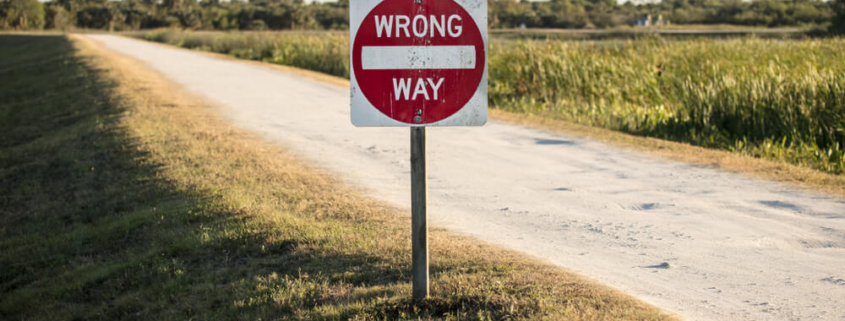Wrong-Way Accidents Increasing Across The US
Headlights of another vehicle coming directly at you from the opposite side when you are driving on a one-way road can be a nerve-wracking experience. Even highly experienced drivers may find themselves to be helpless in this situation and may fail to prevent a wrong-way car accident.
According to an AAA research study, wrong-way accidents can result in devastating injuries in most cases. The at-fault driver in these accidents may be distracted, may have lost direction, or may be driving while intoxicated. There has been a marked increase in the number of wrong-way crashes in recent years across the country and this post will attempt to explain the reasons behind that.
Wrong-Way Accident Statistics
The wrong-way driving crash is described by the Federal Highway Administration (FHWA) as one in which a car traveling in the opposing direction of legal traffic flow on a high-speed access ramp or divided highway hits another car traveling in the right direction on the same highway.
In 2018, these crashes resulted in 428 traffic fatalities. This is up from 415 wrong-way accidents in 2017. These numbers are a part of the analysis released earlier in 2020 by the AAA Foundation for Traffic Safety. According to a recent study, wrong-way accidents were found to have increased by 27 times in the past few decades. They have become one of the most dangerous types of car accidents.
In another study conducted by the California Department of Transportation, the fatality rate was found to be 12 times higher in wrong-way traffic accidents. The fatality rate was found to be 22% in wrong-way collisions as compared to 0.3% in other types of car accidents as found by a Michigan study.
Causes of Wrong-Way Accidents
Data from a variety of traffic safety sources was looked at by researchers for analyzing the factors that contributed the most to wrong-way car collisions. Four factors stood out the most:
- Alcohol impairment
The National Transportation Safety Board (NTSB) reports that alcohol impairment has been, by far, the single major factor in causing wrong-way driving accidents. The statistics have not changed much since 2012 when NTSB issued the special investigation report regarding wrong-way collisions. A AAA study found that 6 out of every 10 or 60.1% of wrong-way drivers that are involved in a vehicular accident had a BAC (blood alcohol concentration) higher than 0.08%.
- Elderly confusion
Drivers above the age of 70 are at a higher risk of being involved in wrong-way driving accidents as compared to their younger counterparts. Typically, older drivers drive fewer miles and spend less time on the road as compared to younger people. Correlating with this, seniors do suffer from cognitive, memory, and vision impairments. This can cause accidents as highlighted by the Insurance Institute for Highway Safety.
- Driving alone
This may not be a direct cause for getting involved in a wrong-way driving accident, but AAA reports that 87% of wrong-way drivers did not have any other passengers in the vehicle. This has led to the hypothesis that the presence of a passenger in the vehicle to alert the driver of their mistake can drastically reduce the number of such accidents.
According to the study, passengers play an important role in alerting drivers when they wrongly enter a one-way road. This allows the driver to take corrective action before the error can result in a crash.
- Issues with road design
Confusion can be heightened when such one-way streets or exit ramps are not properly marked using signs. Poor lighting, faded signs, and foliage-covered signs because of poor maintenance are a few other factors that can lead to confusion. The drivers may think they are traveling in the right direction until they see other vehicles coming toward them.
- Harsh weather conditions
Roadway visibility is affected by certain weather conditions that can cause a head-on collision. Dense or heavy fog and rainfall among other forms of inclement weather can significantly reduce roadway visibility. Drivers that don’t slow down because of decreased visibility increase the risk of causing or being involved in an accident.
- Distracted driving
Driver distraction is by far the most frequently occurring cause of a head-on collision. It is easy for drivers today to become distracted due to mobile usage, car entertainment panel, eating, and other things. Even if you were paying attention to the road, the other driver may be distracted by something in the back seat among other things and cause the accident.
Ways to Prevent Wrong-Way Collisions
The California Department of Transportation (Caltrans) and UC Davis collaborated on a 3-year program in 2020 to pilot several prevention measures. Some of these measures have proved to be highly successful in preventing wrong-way driving accidents. These include:
- Installing 2-way reflective pavement markers blinking red at wrong-way drivers and yellow or white at drivers driving in the right direction
- Signs stating ‘Wrong Way’ at alternate spacings
- LED signs stating ‘Do Not Enter’
- Active monitoring systems that send an alert to the California Highway Patrol when a driver enters the ramp or highway the wrong way
Caltrans noted that there was a 44% reduction in wrong-way accidents in San Diego after the installation of the reflective pavement markers. These measures are continually being implemented in California and other states, such as North Dakota.
Speak with an Experienced Car Accident Attorney Today
Wrong-way accidents are primarily head-on collisions and can result in severe injuries or even the death of the victims. The skilled wrong-way car accident attorneys at Garmo & Garmo, LLP can help you seek maximum compensation to pay for your medical expenses, pain and suffering, and lost wages, among other things. To request a free consultation with one of our attorneys, call us at 619-441-2500 or complete this online form.




